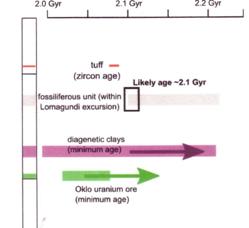The first eukaryotes

I have been looking into the question of the fossil evidence for eukaryote protists first appearing on Earth, after the initial period from ~3800Ma when the first protozoa (cyanobacteria) were the sole life forms and by photosynthesis gave rise to the oxygenic atmosphere. My search was related to an article that I am writing entitled ‘Are we alone? The evolution factor in the context of the exoplanet-proliferated universe’ which I intend to aim for the meeting of the Meteoritical Society in Greenwich in 2011. I concluded, on reading the literature, that:
“There is no agreement among scientists as to when exactly unicellular eukaryote protists, with organelles developed: 3200Ma, 2300Ma, 1200Ma and even 900Ma have been suggested: some unicellular protists occasionally developed multicellular forms, and multicellular life seems to have developed from them (the kingdoms of animals, plants and fungi): protists adopted both asexual and sexual reproduction, and the latter required the initiation of DNA etc., a complex mechanism with the double helix, but there seems to be no evidence as exactly at what time in the geological record this happened”.
Coincidentally there has now been a discovery in Franceville, SE Gabon, in rocks of the Francevillian Group, which are confidently dated at 2.1Ga. There is confirmation from a known
13C excursion, the Lomagundi excursion. The flattened dish-like fossils are found within a black shale unit, in a marine delta environment following a rapid burial event. Sulphate-reducing bacteria decomposed them to pyrite, leaving a durable mineralised impression
1. About 250 fossils 10-120 mm long were recovered. Though they could be a bacterial mat, the authors of the article describing them, Albani et al.
2, used high resolution X-ray tomographic scans to reveal complex internal 3-D structure. They say that they are not bacterial colonies – they do not know of any other colony in the Precambrian fossil bacteria. These organisms are almost certainly multicellular eukaryotes – i.e., possessing organelles and DNA. They are believed to have lived in the sea 20-30m down and breathed oxygen. If this identification is correct, and evidence of steranes, chemical biomarkers of eukaryotes, was obtained supporting this identification, they appeared long before the first filamentous algae (eukaryotes) at 1.6Ga. They post- dated the Great Oxidation event at 2.4Ga, so could readily obtain oxygen.
This discovery is obviously of critical significance. The fossil record prior to the Ediacara soft bodied fossils4 (Neoproterozoic, ~600Ma onwards, just into the Cambrian) is so patchy that any discovery of fossils in the earlier Proterozoic rocks is important.
References
- Rowan, C 2010. How do we know Gabon’s ‘multicellular’ fossils are 2.1 billion years old? http://all-geo.org/highlyallochthonous/2010/07/how-do-we-know-gabons-multicellula
- Albani, A, Bergstrom, S, Canfield, D et al. 2010. Large colonial organisms with co-ordinated growth in oxygenated environments 2.1 ?ã Gyr ago. Nature 466(7302), 100-104.
- Complex organisms 2.1 billion years. http://www.scienceknowledge.org/2010/08/12/complex-organisms-2-1-billion-years/
- McCalll, G J H 2006. The Vendian (Ediacaran) in the geological record: Enigmas in geology’s prelude to the Cambrian explosion. Earth Science Reviews 77, 1-229.